The most beautiful geysers on the planet. What are geysers and where can you find them?
Geysers are incredibly beautiful and mysterious phenomena nature, manifestations of its deep power and processes hidden from us. I bring to your attention a selection of famous geyser fields in the world.
Beppu, Japan
In the northeast of the island of Kyushu is the capital of hot springs of Japan - the city of Beppu. The sacred springs of the same name shelter on their territory about 2,800 springs, fumaroles and microgeysers. Particular attention of visitors is attracted by the so-called “Nine Circles of Hell” - nine unusual sources, each of which has a certain zest. For example, the Shaved Head Spring (Oniishibozu Jigoku) resembles a large boiling gray puddle.The unusual name appeared due to the bubbles resembling the shaved heads of Buddhist monks. But perhaps the most famous source is considered Blood Pond(Chinoike Jigoku). The unusual name appeared due to the red color of the reservoir, “colored” by iron-containing minerals. 
El Tatio, Chile
There are five large geothermal areas on Earth with active geysers - four of them are located in Iceland, New Zealand, the USA and Kamchatka. The fifth valley of geysers is hidden far and high. On the border of Chile with Bolivia, at an altitude of 4,320 meters above sea level in the Andes, there is the highest geyser field in the world - El Tatio (Spanish: El Tatio).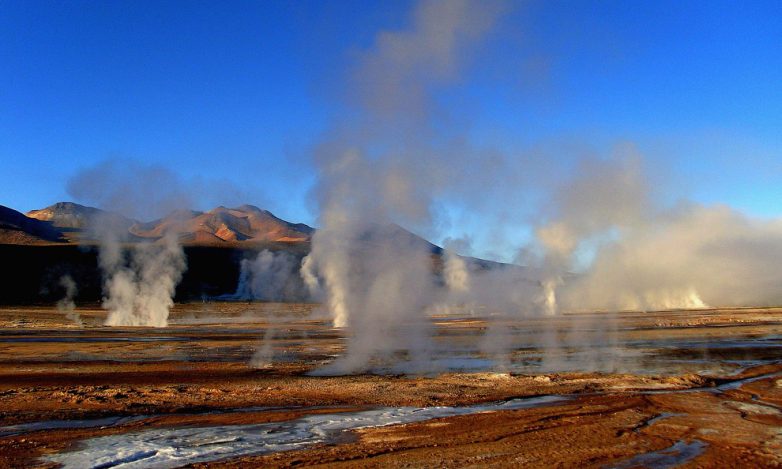
About 80 geysers release boiling water from the depths of the earth, reaching a height of 75 cm to 6-7 m. The best time Sunrise is considered the best time to visit the valley. At a time when the air temperature reaches below zero, each of the sources is surrounded by a special halo of steam.
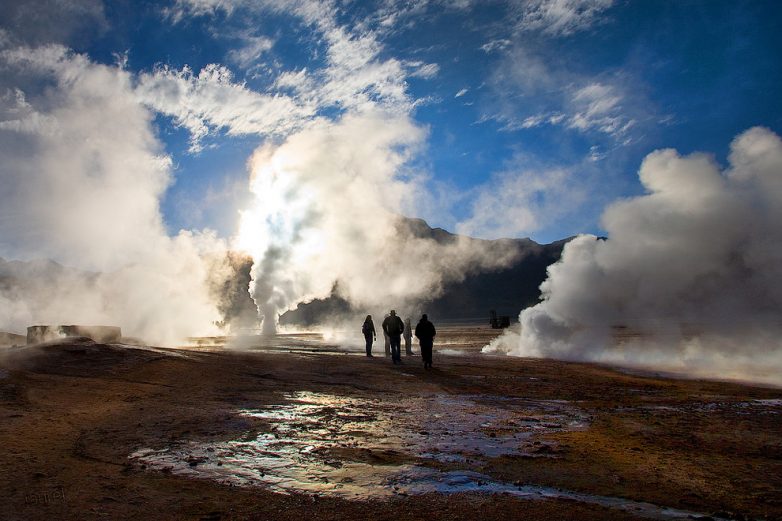
In addition, the springs begin to gush before dawn and cease their activity by nine o'clock in the morning. 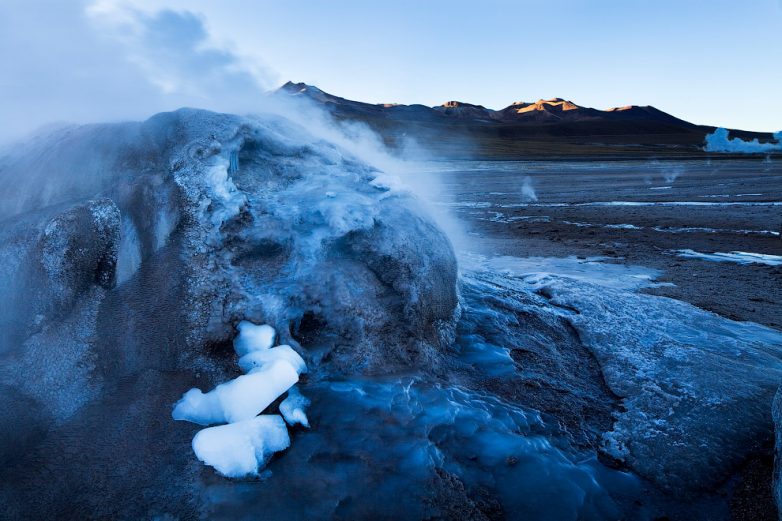
Haukadalur, Iceland
The word "geyser" comes from the Icelandic "geysa", which means "to gush out". The very first documented known to the world geysers, Geysir was discovered in 1294. He gave the name to all the boiling and gushing springs of the world. Like most of Iceland's geysers, Geysir is located in the southeastern part of the island, in the Haukadalur valley, which literally means "hot spring garden." Unfortunately, the legendary Geysir lost its activity as a result of the 2000 earthquake. But he was replaced by Strokkur. It erupts every 5-10 minutes, throwing a stream of hot water to a height of up to 20 meters. Thanks to its restlessness, it is considered one of the most active geysers in the world.Beginning of the eruption of the Strokkur geyser:

Like any geyser, the work of Strokkur consists of several stages: filling the basin with water, steaming, releasing a hot stream of water and the resting stage:


In this picture you can see in detail all the phases of the eruption.

The largest and most powerful geyser in the world was located in New Zealand - the height to which it raised boiling water at times reached 400–450 meters. Waimangu was active for only 4 years, starting in 1900. A photograph from the 1913 book Picturesque New Zealand shows its spectacular eruption:

It is noteworthy that until recently the Icelandic Valley of Geysers was the property of director Sigurdur Jonasson, who donated it to the state. He purchased the area in 1935. Previous owner James Craig, whiskey distiller and later Prime Minister Northern Ireland, fenced off the springs and charged people an entrance fee. Today, everyone can see Icelandic geysers completely free of charge. By the way, there are about 30 active geysers in the country.
Yellowstone, USA
On the other side Pacific Ocean there is a geyser that erupts higher than all other active geysers in the world. This source is located in national park Yellowstone (USA) and is named Steamboat. It throws a stream of water 91 meters up, which is almost equal to the height of the Statue of Liberty (93 m from the ground to the tip of the torch). Its power is so great that old pine trees growing nearby were broken and washed away during one of the eruptions. By the way, it lasts from 3 to 40 minutes. This geyser is unpredictable: it can wake up once every four days, or it can fall asleep for 50 years, as it did in 1911. After a long lull, the Steamboat woke up in 1961 - two years after one of the strongest earthquakes (magnitude 7.5) that occurred in the area of Lake Hebgen. This year, on July 31, the geyser became active for the first time in the last eight years.
The park's other popular geyser, Old Faithful, erupts more frequently and is renowned for its punctuality. Almost every 90 minutes it throws jets of hot water to a height of more than 40 meters:

No less popular among visitors is the Grand Prismatic Spring, a boiling cauldron measuring 91 m long and 75 m wide. It is known for its acidic colors that change with the seasons thanks to pigmented bacteria living in the pond.
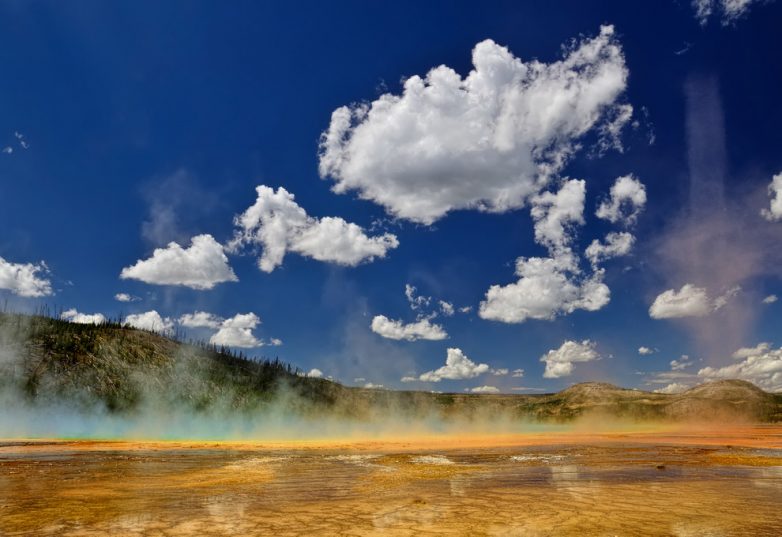

By the way, Yellowstone National Park is home to a record number of geysers. On an area of 8,983 square kilometers, about 3 thousand hot springs pulsate, which is two-thirds of the total number of all geysers in the world. Also see the article Traveling through Yellowstone National Park.

Valley of Geysers, Russia
The Valley of Geysers was discovered 7 years after the founding of the Kronotsky Nature Reserve. This happened in the summer of 1941 during the expedition of Tatyana Ustinova and Anisifor Krupenin. The inaccessibility of the Valley of Geysers did not allow us to discover this unique place earlier. Clickable, 1600×1060 px. (Photo by Dimarik):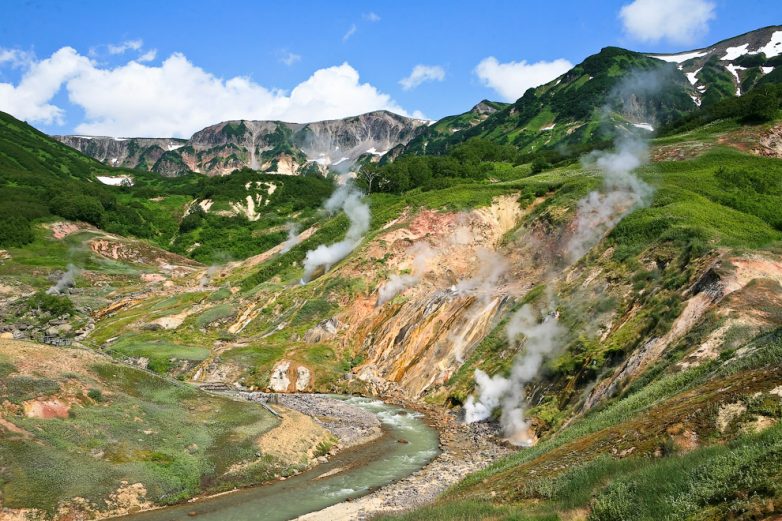
However, even today not everyone can see Kamchatka geysers. Firstly, the only way to get to them is by helicopter, and secondly, visiting is only possible with the permission of the administration. The Valley of Geysers is a gorge up to 4 km wide and 8 km long, along the bottom of which the Geysernaya River flows. Over a distance of 6 km from the mouth of the river, the slopes of the canyon are covered with about 40 geysers, thermal springs, mud pots and volcanoes.
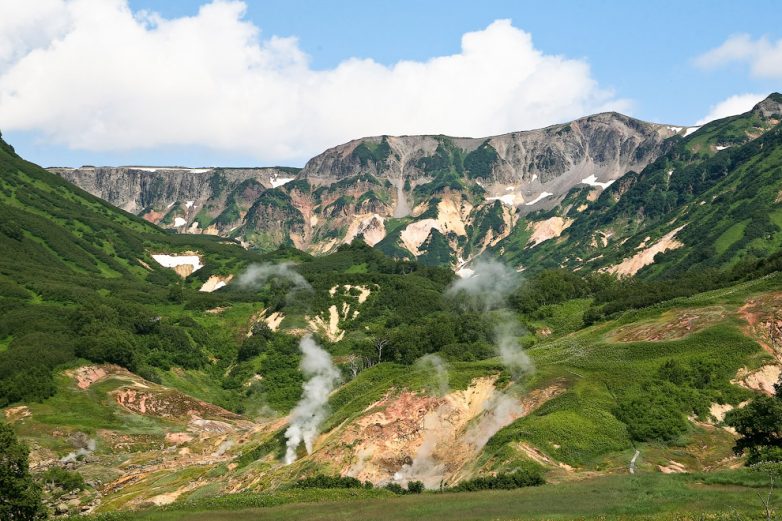
The pride of the valley is the Giant Geyser. It does not erupt frequently - its cycle is 5-7 hours. But when he wakes up, a stream of boiling water under pressure rises 20-30 meters high, and clouds of steam can reach 300 meters!

Five years ago, 14 km from the Valley of Geysers, the youngest geyser in Russia erupted. It became an unexpected discovery for the employees of the Kronotsky Nature Reserve when, on September 28, 2008, a stream of boiling water rose up from under the Kamchatka soil in the middle of one of the most active hydrothermal systems in Kamchatka in the Uzon Valley. It is believed that the “Pulsating” spring previously erupted at this location. Tourists who were nearby at that moment were allowed to call the newly formed “fountain”. If the staff of the reserve had not come to their senses in time, the geyser would have received the name “Cool”. As a result, they called it “Mudty”. At first it erupted every 15-20 minutes, a year later - approximately every 12 minutes, in 2010 - an hour and forty minutes. Today the steam jet rises 5-6 meters every 2-3 hours, but its cycle depends on the weather. The geyser reacts to strong winds and temperature changes, which affects its activity.

Geysers are springs that periodically emit hot water and steam in the form of a fountain.
For the birth and existence of these “water volcanoes,” a complex of three underground factors is needed:
- a special system of cavities and channels.
The water erupted by a geyser seeps underground after rains, melting snow, and from the beds of rivers and lakes. It can reach a maximum depth of approximately 2 km. For a geyser to appear, there must be a heat source here. This only happens in active volcanic areas, where molten rocks and gases heat up and move in the depths.
Water heated in an underground “stove” can return through cracks and pores to the surface in the form of ordinary hot springs. But sometimes it accumulates in a cavity, from which one or several narrow channels lead upward. It is through them that the water is pushed out. The Old Faithful geyser (USA) releases up to 32 thousand liters of boiling water during a five-minute eruption. It is not surprising that in Iceland houses and greenhouses are heated with geyser water.
Many geysers are both colorful and rare phenomena nature - objects of attention of tourists. The pools around the opening of the geysers are inhabited by bacteria that love warmth and thrive in very hot water. Geysers gave them a chance to settle far to the North.
What makes geysers erupt?
The opinions of geologists differ here. One theory paints such a scenario.
Groundwater accumulates in the fault of dense and strong rocks. They do not allow moisture to seep through them. Exit is possible only through cracks-channels that narrow upward and open somewhere on the surface. 
The water in the canal cools down and, according to the laws of physics, tends to sink. But heating from below creates water pressure and does not allow it to do so. As a result, the water in the middle of the channel is compressed both above and below.
Even when heated to 100°C, it does not boil due to increased pressure. The superheated water rises higher along the channel, here the pressure weakens, and it begins to boil. The steam sharply increases in volume and flies out along with the boiling water through the outlet. Next, part of the boiling water from the tank is thrown out.
Outside, the steam instantly cools and turns into a cloud. The foam settles, part of the water flows back into the channel - until the next eruption.
Where can you find geysers?
There are not many places on Earth where all three conditions necessary for the birth of geysers converge at once. There are five known geyser fields: in Iceland, in the Valley of Geysers canyon in Kamchatka, Yellowstone National Park (USA), the El Tatio mountain region in northern Chile, near the Taupo volcano on the North Island of New Zealand.
What is the most famous geyser in the world?
Perhaps the one that is located in Iceland and has been active for 10 thousand years. In time immemorial, it was nicknamed Geysir, from the Icelandic “geysa” - to gush. This periodic fountain was the first to be described in a printed book. Already in the 18th century, he was known throughout Europe, and later such phenomena began to be called geysers in his honor.
Initially, the site with this miracle of nature belonged to a local farmer, who sold it to a businessman who surrounded the geyser with a high fence and allowed spectators only for a fee. The owners changed, the last one in 1935 donated the site “to the Icelandic people in perpetuity.”
Geysir once erupted every half hour. He survived several earthquakes, which clearly invigorated him. After the earthquake in 2000, the fountain doubled in size and for a couple of days it was as high as a 40-story skyscraper! Nowadays the fountain has become much lower and appears only three times a day. 
Experts have learned how to clear a geyser channel when it becomes clogged. Especially a lot of people gather here on June 17 - Independence Day. The day before, geologists were working here on instructions from the government. Their duty is to provide festive “fireworks” for the old-time geyser, and it never fails.
On November 1, 1934, the Kronotsky State Natural Reserve was established in Kamchatka biosphere reserve, which houses one of the wonders of Russia - the Valley of Geysers.
In honor of this event, we present to your attention a selection of famous geyser fields around the world.
Beppu, Japan
In the northeast of the island of Kyushu is the hot spring capital of Japan - the city of Beppu.
The sacred springs of the same name shelter on their territory about 2,800 springs, fumaroles and microgeysers.
Particular attention of visitors is attracted by the so-called “Nine Circles of Hell” - 9 unusual sources, each of which has a certain zest.
For example, the Shaved Head Spring (Oniishibozu Jigoku) resembles a large boiling gray puddle. 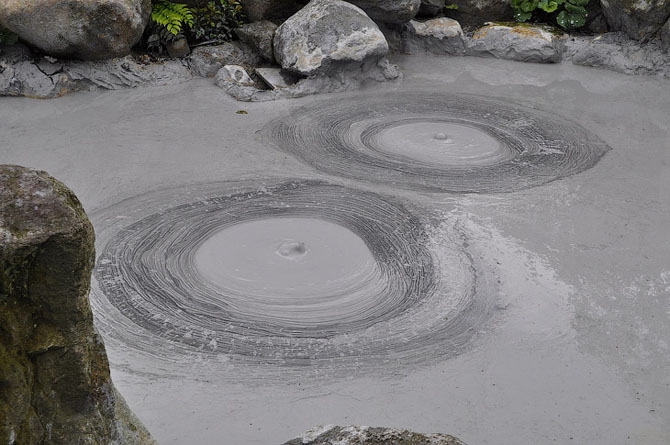
The unusual name appeared due to the bubbles resembling the shaved heads of Buddhist monks.
But perhaps the most famous source is the Bloody Pond
(Chinoike Jigoku).
The unusual name appeared due to the red color of the reservoir, “colored” by iron-containing minerals. 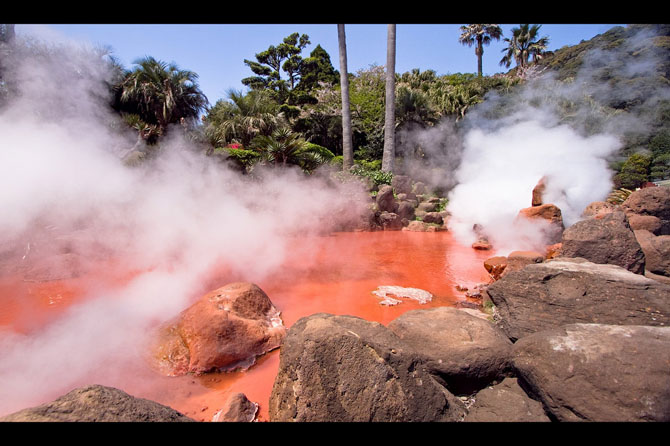
El Tatio, Chile
There are 5 large geothermal areas on Earth with active geysers - 4 of them are located in Iceland, New Zealand, the USA and Kamchatka.
The 5th Valley of Geysers is hidden far and high.
On the border of Chile with Bolivia, at an altitude of 4,320 m above sea level in the Andes, there is the highest geyser field in the world - El Tatio 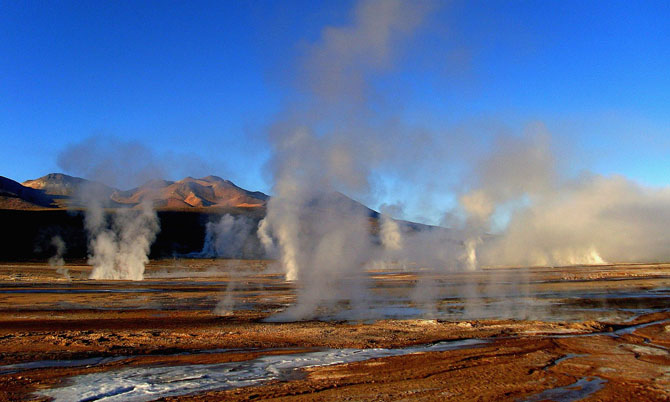
About 80 geysers release boiling water from the depths of the earth, reaching a height of 75 cm to 6-7 m.
The best time to visit the valley is considered to be dawn.
At a time when the air temperature reaches below zero, each of the sources is surrounded by a special halo of steam.
In addition, the springs begin to gush before dawn and stop
your activity by 9 am. 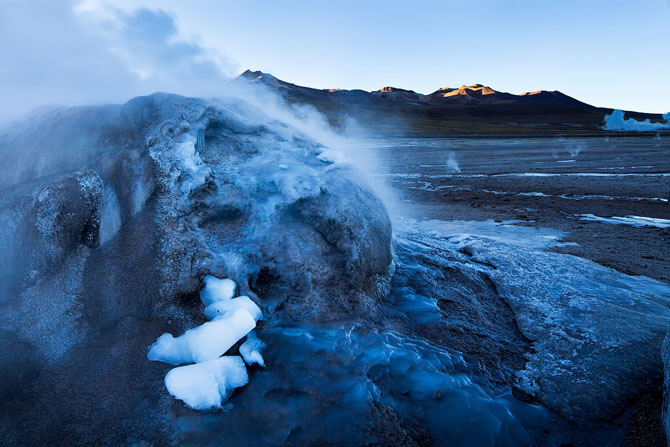
Haukadalur, Iceland
The word "geyser" comes from the Icelandic "geysa", which means "to gush out".
The earliest documented and known the world of geysers,
Geysir was opened in 1294.
He gave the name to all the boiling and gushing springs of the world.
Like most geysers in Iceland, Geysir is located in the southeastern part of the island, in a valley
Haukadalur literally means "hot spring garden".
Unfortunately, the legendary Geysir lost its activity as a result of the 2000 earthquake.
But he was replaced by Strokkur.
It erupts every 5-10 minutes, throwing a stream of hot water to a height of up to 20 m.
Thanks to its restlessness, it is considered one of the most active geysers in the world.
Like any geyser, Strokkur’s work consists of several stages:
filling the basin with water, steaming, releasing a hot stream of water and the resting stage:
In this picture you can see in detail all the phases of the eruption.

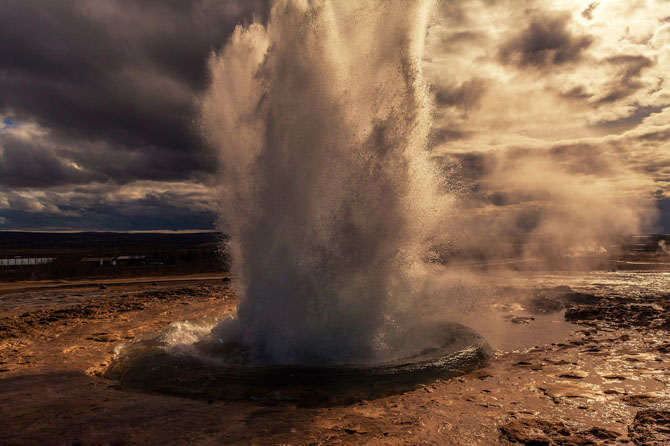
It is noteworthy that until recently the Icelandic Valley of Geysers was the property of director Sigurdur Jonasson, who donated it to the state.
He purchased the area in 1935.
The previous owner, James Craig, a whiskey distiller and later prime minister of Northern Ireland, fenced the springs and charged people an entrance fee.
Today, everyone can see Icelandic geysers completely free of charge.
By the way, there are about 30 active geysers in the country. 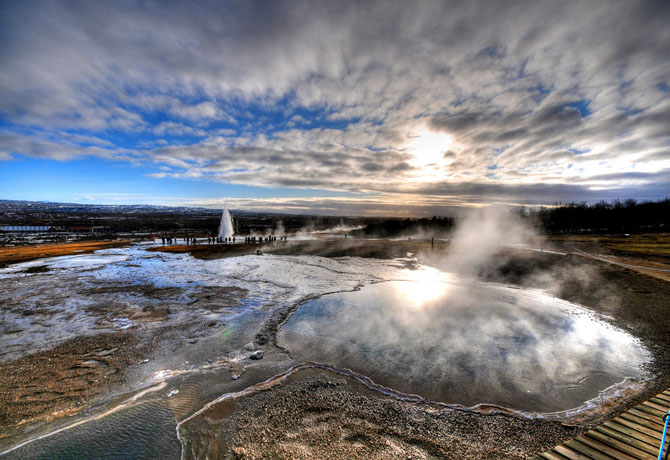
Waimangu. New Zealand.
The largest and most powerful geyser in the world was located in New Zealand - the height to which it raised boiling water at times reached 400-450 m.
Waimangu was active for only 4 years, starting in 1900.
A photograph from the 1913 book Picturesque New Zealand shows its spectacular eruption: 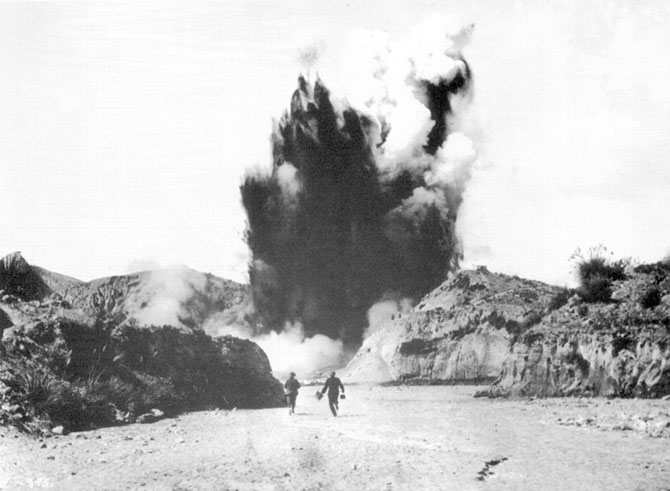
Yellowstone, USA
On the other side of the Pacific Ocean lies a geyser that erupts higher than all other active geysers in the world.
This source is located in Yellowstone National Park (USA) and bears the name
Steamboat.
It throws a stream of water 91 m up, which is almost equal to the height of the Statue of Liberty (93 m from the ground to the tip of the torch).
Its power is so great that old pine trees growing nearby were broken and washed away during one of the eruptions; by the way, it lasts from 3 to 40 minutes.
This geyser is unpredictable: it can wake up once every 4 days, or it can fall asleep for 50 years, as it did in 1911.
After a long lull, the Steamboat woke up in 1961 - 2 years after one of the strongest earthquakes (magnitude 7.5) that occurred in the area of Lake Hebgen.
This year, on July 31, the geyser became active for the first time in the last 8 years. 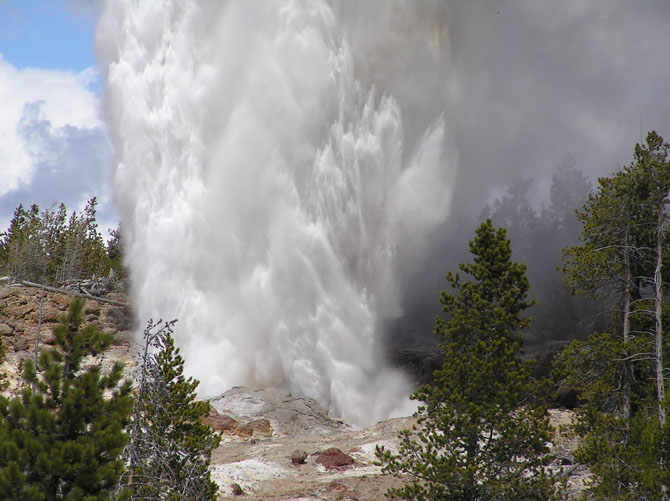
The park's other popular geyser, Old Faithful, erupts more frequently and is renowned for its punctuality.
Almost every 90 minutes it throws jets of hot water to a height of more than 40 m: 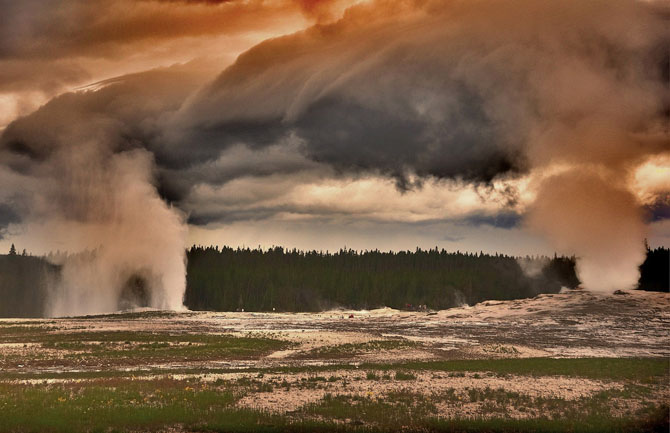
No less popular among visitors is the Grand Prismatic Spring, a boiling cauldron measuring 91 m long and 75 m wide.
It is known for its acidic colors that change with the seasons thanks to pigmented bacteria living in the pond. 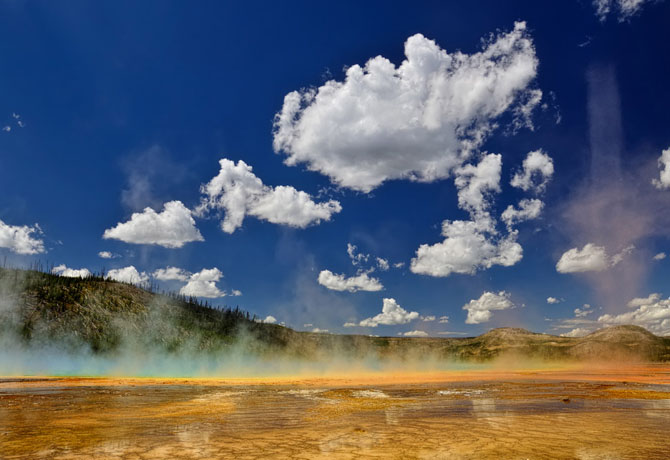
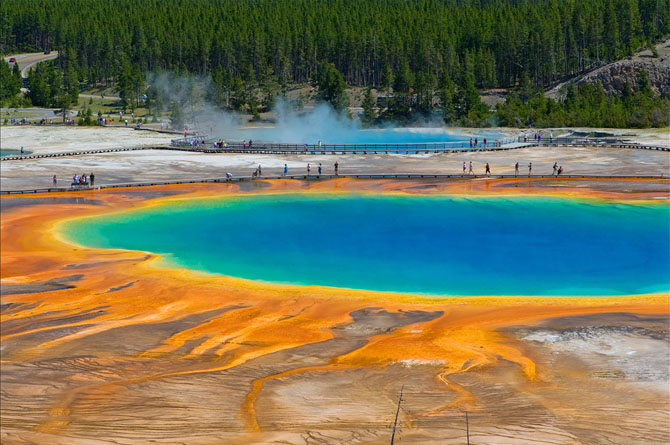
By the way, Yellowstone National Park is home to a record
number of geysers.
On an area of 8,983 square kilometers, about 3 thousand hot springs pulsate, which is 2/3 of the total number of all geysers in the world. ![]()
Valley of Geysers, Russia
The Valley of Geysers was discovered 7 years after the founding of the Kronotsky Nature Reserve.
This happened in the summer of 1941 during the expedition of Tatyana Ustinova and Anisifor Krupenin.
The inaccessibility of the Valley of Geysers did not allow us to discover this unique place earlier. ![]()
However, even today not everyone can see Kamchatka geysers.
Firstly, the only way to get to them is by helicopter, and secondly, visiting is only possible with the permission of the administration.
The Valley of Geysers is a gorge up to 4 km wide and 8 km long, along the bottom of which the Geysernaya River flows.
Over a distance of 6 km from the mouth of the river, the slopes of the canyon are covered with about 40 geysers, thermal springs, mud pots and volcanoes. 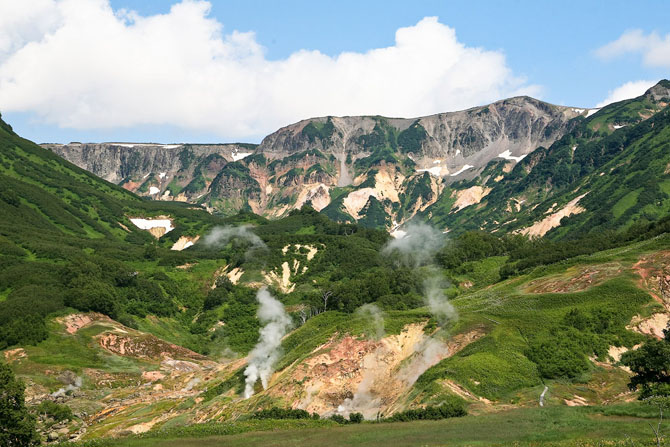
The pride of the valley is the Giant Geyser.
It does not erupt frequently - its cycle is 5-7 hours.
But when he wakes up, a stream of boiling water under pressure rises 20-30 m high, and clouds of steam can reach 300 m! 
5 years ago, 14 km from the Valley of Geysers, the youngest geyser in Russia erupted.
It became an unexpected discovery for the employees of the Kronotsky Nature Reserve when, on September 28, 2008, a stream of boiling water rose up from under the Kamchatka soil in the middle of one of the most active hydrothermal systems in Kamchatka in the Uzon Valley.
It is believed that the “Pulsating” spring previously erupted at this location.
Tourists who were nearby at that moment were allowed to call the newly formed “fountain”.
If the staff of the reserve had not come to their senses in time, the geyser would have received the name “Cool”.
As a result, they called it “Mudty”.
At first it erupted every 15-20 minutes, a year later - approximately every 12 minutes, in 2010 - an hour and 40 minutes.
Today the steam jet rises 5-6 m every 2-3 hours, but its cycle depends on the weather.
The geyser reacts to strong winds and temperature changes, which affects its activity. 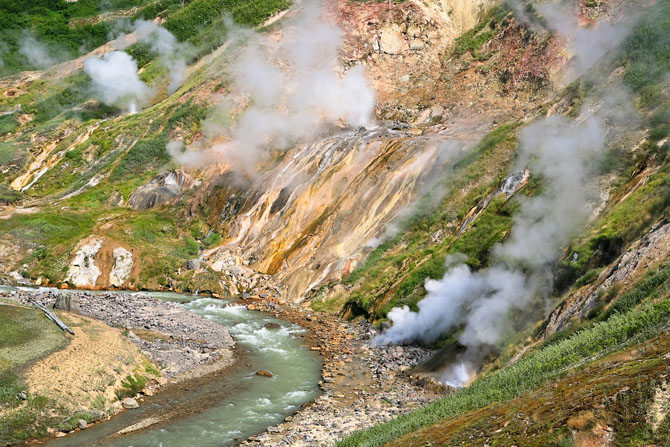
1. Valley of Geysers, Russia The Valley of Geysers was discovered 7 years after the founding of the Kronotsky Nature Reserve. This happened in the summer of 1941 during the expedition of Tatyana Ustinova and Anisifor Krupenin. The inaccessibility of the Valley of Geysers did not allow us to discover this unique place earlier. However, even today not everyone can see Kamchatka geysers. Firstly, the only way to get to them is by helicopter, and secondly, visiting is only possible with the permission of the administration. The Valley of Geysers is a gorge up to 4 km wide and 8 km long, along the bottom of which the Geysernaya River flows. Over a distance of 6 km from the mouth of the river, the slopes of the canyon are covered with about 40 geysers, thermal springs, mud pots and volcanoes. The pride of the valley is the Giant Geyser. It does not erupt frequently - its cycle is 5-7 hours. But when he wakes up, a stream of boiling water under pressure rises 20-30 meters high, and clouds of steam can reach 300 meters!
Five years ago, 14 km from the Valley of Geysers, the youngest geyser in Russia erupted. It became an unexpected discovery for the employees of the Kronotsky Nature Reserve when, on September 28, 2008, a stream of boiling water rose up from under the Kamchatka soil in the middle of one of the most active hydrothermal systems in Kamchatka in the Uzon Valley. It is believed that the “Pulsating” spring previously erupted at this location. Tourists who were nearby at that moment were allowed to call the newly formed “fountain”. If the staff of the reserve had not come to their senses in time, the geyser would have received the name “Cool”. As a result, they called it “Mudty”. At first it erupted every 15-20 minutes, a year later - approximately every 12 minutes, in 2010 - an hour and forty minutes. Today, the steam jet rises 5-6 meters every 2-3 hours, but its cycle depends on the weather. The geyser reacts to strong winds and temperature changes, which affects its activity.
2. Yellowstone, USA
On the other side of the Pacific Ocean there is a geyser that erupts higher than the Kamchatka Giant and all other active geysers in the world. This source is located in Yellowstone National Park (USA) and is named Steamboat. It throws a stream of water 91 meters up, which is almost equal to the height of the Statue of Liberty (93 m from the ground to the tip of the torch). Its power is so great that old pine trees growing nearby were broken and washed away during one of the eruptions. By the way, it lasts from 3 to 40 minutes. This geyser is unpredictable: it can wake up once every four days, or it can fall asleep for 50 years, as it did in 1911. After a long lull, the Steamboat woke up in 1961 - two years after one of the strongest earthquakes (magnitude 7.5) that occurred in the area of \u200b\u200bLake Hebgen. This year, on July 31, the geyser became active for the first time in the last eight years. The park's other popular geyser, Old Faithful, erupts more frequently and is renowned for its punctuality. Almost every 90 minutes it throws jets of hot water to a height of more than 40 meters. No less popular among visitors is the Grand Prismatic Spring, a boiling cauldron measuring 91 m long and 75 m wide. It is known for its acidic colors that change with the seasons thanks to pigmented bacteria living in the pond. By the way, Yellowstone National Park is home to a record number of geysers. On an area of 8983 square kilometers, about 3 thousand hot springs pulsate, which is two-thirds of the total number of all geysers in the world.
3. Haukadalur, Iceland
The word "geyser" comes from the Icelandic "geysa", which means "to gush out". The very first geyser documented and known to the world, Geysir, was discovered in 1294. He gave the name to all the boiling and gushing springs of the world. Like most of Iceland's geysers, Geysir is located in the southeastern part of the island, in the Haukadalur valley, which literally means "hot spring garden." Unfortunately, the legendary Geysir lost its activity as a result of the 2000 earthquake. But he was replaced by Strokkur. It erupts every 5-10 minutes, throwing a stream of hot water to a height of up to 20 meters. Thanks to its restlessness, it is considered one of the most active geysers in the world.
It is noteworthy that until recently the Icelandic Valley of Geysers was the property of director Sigurdur Jonasson, who donated it to the state. He purchased the area in 1935. The previous owner, James Craig, a whiskey distiller and later prime minister of Northern Ireland, fenced the springs and charged people an entrance fee. Today, everyone can see Icelandic geysers completely free of charge. By the way, there are about 30 active geysers in the country.
4. Waimangu, New Zealand
The northern island of the country has long been known for its geysers, in honor of which the aborigines nicknamed this part of New Zealand “the land of hot water.” As a result of the eruption of Mount Tarawera on June 10, 1886, the most powerful geyser in the world, Waimangu, was born, which was active from 1900 to 1904. During the “session” he threw out about 800 tons of water. In 1902, the hot water fountain rose to a record height of 450 meters. But two years later, in 1904, the legendary fountain ceased to exist. It was replaced by geysers of a calmer nature, which you can admire 20 km from the town of Rotorua, in the Waimangu Valley. On its territory there is a complex of geothermal springs, the most powerful of which is the Pohutu geyser. Every hour it splashes out a stream of hot water 30 meters into the air. He keeps at least company famous geyser"Prince of Wales's Feathers", which delights numerous tourists with a hot show every 20 minutes.
5. El Tatio, Chile
There are five large geothermal areas on Earth with active geysers - four of them are in Iceland, New Zealand, the USA and Kamchatka. The fifth valley of geysers is hidden far and high. On the border of Chile with Bolivia, at an altitude of 4320 meters above sea level in the Andes, there is the highest geyser field in the world - El Tatio (Spanish: El Tatio). About 80 geysers release boiling water from the depths of the earth, reaching a height of 75 cm to 6-7 m. The best time to visit the valley is considered to be dawn. At a time when the air temperature reaches below zero, each of the sources is surrounded by a special halo of steam. In addition, the springs begin to gush before dawn and cease their activity by nine o'clock in the morning.
6. Beppu, Japan
In the northeast of the island of Kyushu is the hot spring capital of Japan - the city of Beppu. The sacred springs of the same name shelter on their territory about 2800 springs, fumaroles and microgeysers. Particular attention of visitors is attracted by the so-called “Nine Circles of Hell” - nine unusual sources, each of which has a certain zest. For example, the Shaved Head Spring (Oniishibozu Jigoku) resembles a large boiling gray puddle. The unusual name appeared due to the bubbles resembling the shaved heads of Buddhist monks. But perhaps the most famous source is the Bloody Pond (Chinoike Jigoku). The unusual name appeared due to the red color of the reservoir, “colored” by iron-containing minerals.
Beppu, Japan
In the northeast of the island of Kyushu is the hot spring capital of Japan - the city of Beppu. The sacred springs of the same name shelter on their territory about 2,800 springs, fumaroles and microgeysers. Particular attention of visitors is attracted by the so-called “Nine Circles of Hell” - nine unusual sources, each of which has a certain zest. For example, the Shaved Head Spring (Oniishibozu Jigoku) resembles a large boiling gray puddle.
The unusual name appeared due to the bubbles resembling the shaved heads of Buddhist monks. But perhaps the most famous source is the Bloody Pond (Chinoike Jigoku). The unusual name appeared due to the red color of the reservoir, “colored” by iron-containing minerals.
El Tatio, Chile
There are five large geothermal areas on Earth with active geysers - four of them are in Iceland, New Zealand, the USA and Kamchatka. The fifth valley of geysers is hidden far and high. On the border of Chile with Bolivia, at an altitude of 4,320 meters above sea level in the Andes, there is the highest geyser field in the world - El Tatio
About 80 geysers release boiling water from the depths of the earth, reaching a height of 75 cm to 6-7 m. The best time to visit the valley is considered to be dawn. At a time when the air temperature reaches below zero, each of the sources is surrounded by a special halo of steam.
In addition, the springs begin to gush before dawn and cease their activity by nine o'clock in the morning.
Haukadalur, Iceland
The word "geyser" comes from the Icelandic "geysa", which means "to gush out". The very first geyser documented and known to the world, Geysir, was discovered in 1294. He gave the name to all the boiling and gushing springs of the world. Like most of Iceland's geysers, Geysir is located in the southeastern part of the island, in the Haukadalur valley, which literally means "hot spring garden." Unfortunately, the legendary Geysir lost its activity as a result of the 2000 earthquake. But he was replaced by Strokkur. It erupts every 5-10 minutes, throwing a stream of hot water to a height of up to 20 meters. Thanks to its restlessness, it is considered one of the most active geysers in the world.
Beginning of the eruption of the Strokkur geyser:
Like any geyser, the work of Strokkur consists of several stages: filling the basin with water, steaming, releasing a hot stream of water and the resting stage:
In this picture you can see in detail all the phases of the eruption.
The largest and most powerful geyser in the world was located in New Zealand - the height to which it raised boiling water sometimes reached 400-450 meters. Waimangu was active for only 4 years, starting in 1900. A photograph from the 1913 book Picturesque New Zealand shows its spectacular eruption:
It is noteworthy that until recently the Icelandic Valley of Geysers was the property of director Sigurdur Jonasson, who donated it to the state. He purchased the area in 1935. The previous owner, James Craig, a whiskey distiller and later prime minister of Northern Ireland, fenced the springs and charged people an entrance fee. Today, everyone can see Icelandic geysers completely free of charge. By the way, there are about 30 active geysers in the country.
Yellowstone, USA
On the other side of the Pacific Ocean lies a geyser that erupts higher than all other active geysers in the world. This source is located in Yellowstone National Park (USA) and is named Steamboat. It throws a stream of water 91 meters up, which is almost equal to the height of the Statue of Liberty (93 m from the ground to the tip of the torch). Its power is so great that old pine trees growing nearby were broken and washed away during one of the eruptions. By the way, it lasts from 3 to 40 minutes. This geyser is unpredictable: it can wake up once every four days, or it can fall asleep for 50 years, as it did in 1911. After a long lull, the Steamboat woke up in 1961 - two years after one of the strongest earthquakes (magnitude 7.5) that occurred in the area of \u200b\u200bLake Hebgen. This year, on July 31, the geyser became active for the first time in the last eight years.
The park's other popular geyser, Old Faithful, erupts more frequently and is renowned for its punctuality. Almost every 90 minutes it throws jets of hot water to a height of more than 40 meters:
No less popular among visitors is the Grand Prismatic Spring, a boiling cauldron measuring 91 m long and 75 m wide. It is known for its acidic colors that change with the seasons thanks to pigmented bacteria living in the pond.
By the way, Yellowstone National Park is home to a record number of geysers. On an area of 8,983 square kilometers, about 3 thousand hot springs pulsate, which is two-thirds of the total number of all geysers in the world.
Valley of Geysers, Russia
The Valley of Geysers was discovered 7 years after the founding of the Kronotsky Nature Reserve. This happened in the summer of 1941 during the expedition of Tatyana Ustinova and Anisifor Krupenin. The inaccessibility of the Valley of Geysers did not allow us to discover this unique place earlier.
However, even today not everyone can see Kamchatka geysers. Firstly, the only way to get to them is by helicopter, and secondly, visiting is only possible with the permission of the administration. The Valley of Geysers is a gorge up to 4 km wide and 8 km long, along the bottom of which the Geysernaya River flows. Over a distance of 6 km from the mouth of the river, the slopes of the canyon are covered with about 40 geysers, thermal springs, mud pots and volcanoes.
The pride of the valley is the Giant Geyser. It does not erupt frequently - its cycle is 5-7 hours. But when he wakes up, a stream of boiling water under pressure rises 20-30 meters high, and clouds of steam can reach 300 meters!
Five years ago, 14 km from the Valley of Geysers, the youngest geyser in Russia erupted. It became an unexpected discovery for the employees of the Kronotsky Nature Reserve when, on September 28, 2008, a stream of boiling water rose up from under the Kamchatka soil in the middle of one of the most active hydrothermal systems in Kamchatka in the Uzon Valley. It is believed that the “Pulsating” spring previously erupted at this location. Tourists who were nearby at that moment were allowed to call the newly formed “fountain”. If the staff of the reserve had not come to their senses in time, the geyser would have received the name “Cool”. As a result, they called it “Mudty”. At first it erupted every 15-20 minutes, a year later - approximately every 12 minutes, in 2010 - an hour and forty minutes. Today the steam jet rises 5-6 meters every 2-3 hours, but its cycle depends on the weather. The geyser reacts to strong winds and temperature changes, which affects its activity.
